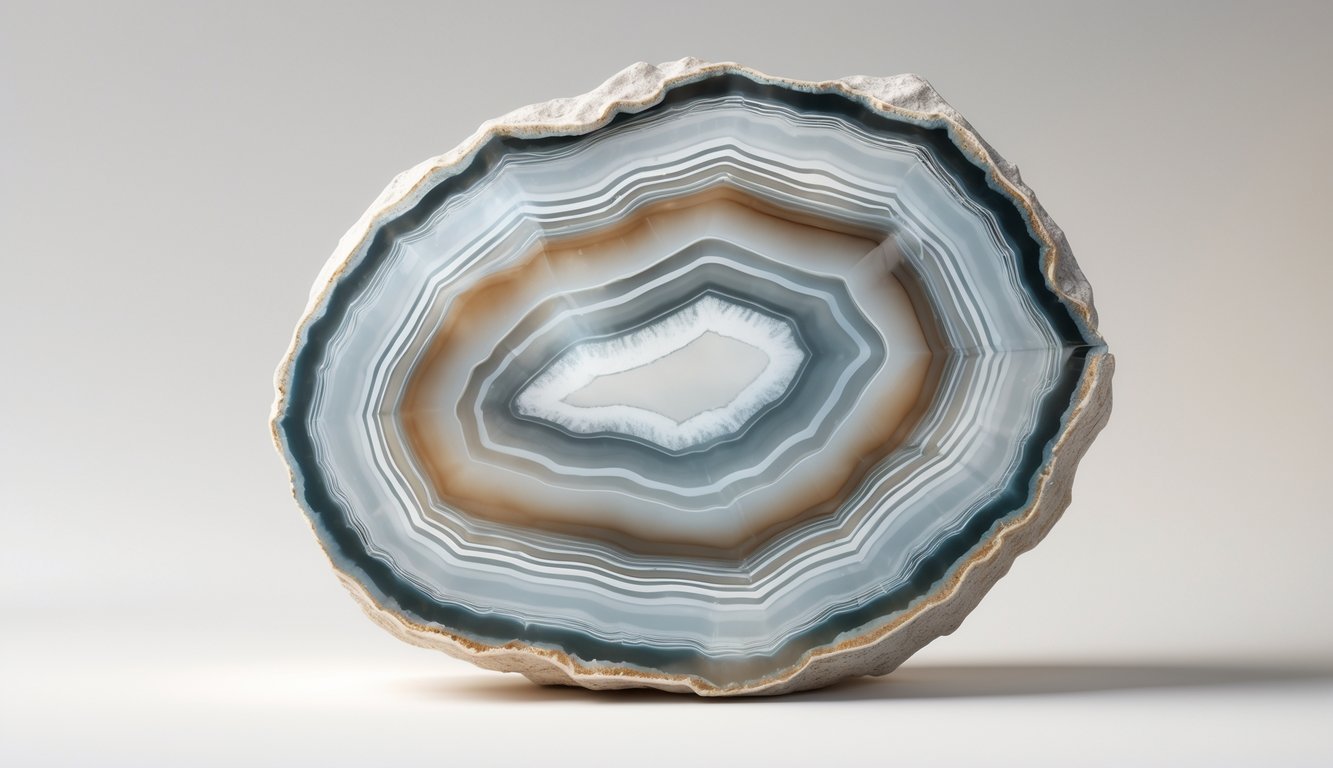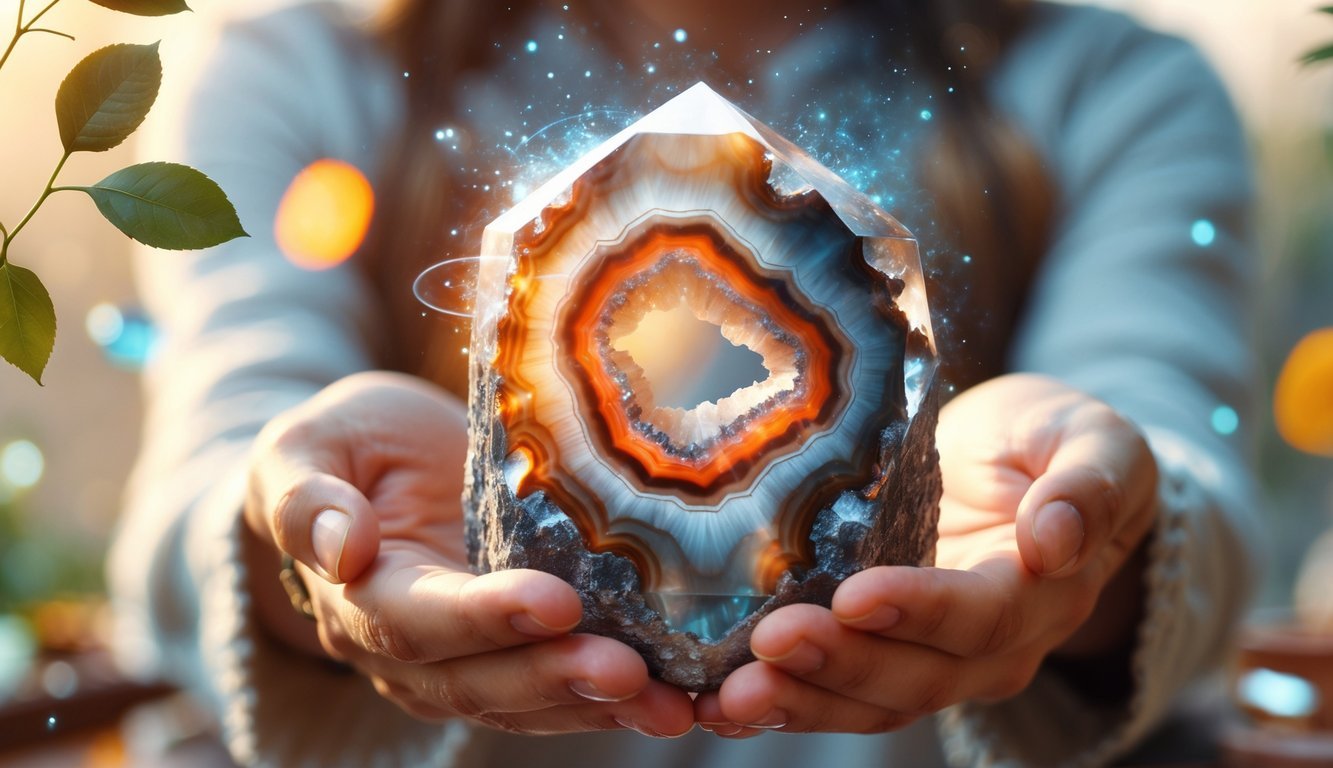Physical Address
304 North Cardinal St.
Dorchester Center, MA 02124
Physical Address
304 North Cardinal St.
Dorchester Center, MA 02124
Agate crystals are colorful, banded gemstones from the quartz family, valued for their unique patterns and emotional stabilization properties. They promote balance and well-being.


Agate crystals belong to the quartz family and show off beautiful bands in all kinds of colors.
You’ll spot them inside volcanic rocks or sometimes tucked into sedimentary layers, so every stone feels a bit one-of-a-kind.
People value agate not just for its looks, but for how it can bring balance and stability into your life.
Many folks turn to agate when they want to calm their emotions or just need a little more stamina.
The natural colors and patterns add something special to jewelry and decor, and at the same time, they support emotional and physical well-being.
If you’re looking for a crystal that mixes natural beauty with a calming vibe, agate could be just what you need.

Agate is a type of gemstone that stands out for its colorful layers and patterns.

It’s part of the quartz family and comes in so many shapes and colors.
You’ll find all sorts of agate, each with its own unique design.
Agate is actually a type of chalcedony, which is a form of quartz.
Quartz mainly contains silicon dioxide, a mineral found all over Earth’s crust.
What sets agate apart is its banded look—lots of layers and stripes.
These layers create striking patterns, usually in white, black, gray, or brown.
Sometimes, agate surprises you with bright blue, red, or green.
The bands might be thick and bold or super thin and delicate.
People have used agate for centuries in jewelry and decorations because it’s tough and looks amazing.
If you hold an agate stone, you can often see and feel the textures from how it formed.
Agate forms inside volcanic rocks as minerals slowly build up over time.
Hot water carrying dissolved minerals seeps into cracks or empty spaces.

As the water cools, minerals like silicon dioxide settle out and start forming those classic bands.
These layers take ages to grow—sometimes millions of years.
That slow process gives agate its detailed patterns and colors.
Other minerals can get mixed in with the quartz, changing the colors and adding special touches.
Quartz is the main mineral in agate, but tiny amounts of other stuff can shift how it looks.
Iron might make it reddish; manganese can add some pink or purple.
The natural layering gives agate its beauty and strength.
There are loads of agate types, each with its own style.
Here are a few you might recognize:
You’ll also find plume agate, eye agate, fortification agate, and turritella agate.
Each one shows off a different look, depending on how it formed.
People love agate for its variety.
You’ll see it in jewelry, or just as polished stones to admire up close.

Agate crystals have played a special role for ages, from ancient stories to modern healing.
Folks turn to them for emotional balance, physical strength, and spiritual growth.
You can use agate in jewelry or as a meditation aid to support well-being and calm your mind.
Agate’s history stretches way back.
The name comes from the Greek “achates,” after the Achates River in Sicily where people first found it.
Ancient Greeks, Babylonians, and Egyptians believed agate could protect them.
People in many cultures wore agate as amulets or used it in ornaments to keep away danger and negative energy.
It stood for strength, courage, and harmony.
Agate was affordable but still beautiful, so it became popular in places like India, Mexico, and Germany.
Stones from famous agate spots like Idar-Oberstein in Germany or mines in Brazil and the U.S. still show up today.
Agate acts as a grounding stone, helping you balance your emotions and energy.
It brings harmony by stabilizing the yin and yang inside you.
People say agate helps with emotional healing, easing anger, stress, and fear.
On the physical side, agate is believed to boost your immune system and help your digestion—especially your stomach and intestines.
Some folks also connect it to eye and heart health.
Agate works well for meditation, since it encourages peace and focus.
Many people use it to clear negative vibes and improve communication, making it easier to connect with others and yourself.
Today, you’ll see agate in rings, necklaces, and bracelets—partly for its looks, partly for the healing energy it’s said to carry.
Lots of people keep agate stones nearby at home or work to stay grounded and calm.
You can use agate in crystal healing sessions for balancing chakras or supporting your emotional health.
Some even put tiny agate pieces in their water, hoping it adds energy and vitality.
Agate is affordable and easy to find, especially from places like Botswana, Australia, and Oregon.
You can add it to your crystal collection or use it as a natural tool for relaxation and protection.

Agate crystals come in lots of types, each with its own color and pattern.
People often link agate with emotional balance and mental clarity.
Collectors and jewelry lovers appreciate agate for its unique bands, and many use it for healing or decoration.
If you know how to spot real agate, you can steer clear of fakes.
You’ll find many types of agate crystals, like moss agate, blue lace agate, and iris agate.
Each one has its own colors and patterns.
For instance, moss agate has green, moss-like inclusions, while blue lace agate shows off soft blue bands.
People believe agate crystals can improve mental focus and emotional balance.
They may help calm your mind and lower stress.
Some folks use them to boost confidence or feel more grounded.
Colors in agate have different meanings.
Blue agate stands for peace and calm.
Red agate often means strength and courage.
Green agate is all about healing and growth.
Agate stands out because of its colorful bands and patterns.
No two stones look exactly the same.
This natural variety makes agate special for collectors and jewelry fans.
People place agate crystals on or near the body to encourage physical and emotional healing.
They often use agate during meditation to help with focus.
Some believe agate helps balance energy, too.
Check for natural banding and colors that look a bit irregular.
Real agate usually feels cool when you touch it.
If a stone looks super bright or kind of plastic, it might be dyed or even fake.
Trust your instincts—sometimes, if it seems too perfect, it probably isn’t the real thing.
